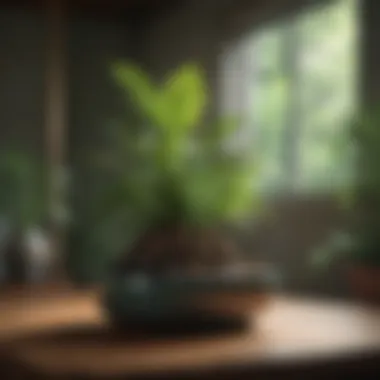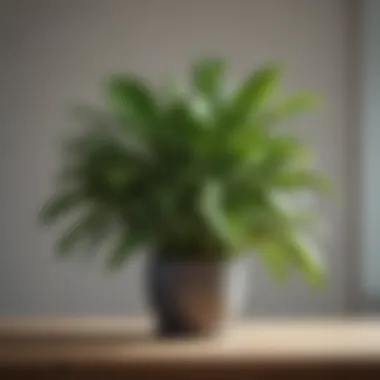Elevate Your Space: Discover Popular Indoor Green Plants for Wellness and Home Decor


Wellness
As we delve into the realm of indoor green plants, it becomes evident that their impact extends beyond mere aesthetics. These botanical wonders offer a plethora of benefits that actively contribute to our overall well-being. Let's start by exploring the physical health advantages associated with these verdant companions.
Physical Health
Indoor green plants play a vital role in enhancing the quality of the air we breathe within our living spaces. Through the process of photosynthesis, these plants effectively remove harmful toxins and pollutants from the air, thereby purifying it and creating a healthier environment for us to inhabit. This purification process not only reduces the risk of respiratory issues but also promotes better overall respiratory health.
Apart from purifying the air, indoor plants have been shown to contribute to the regulation of humidity levels in enclosed spaces. By releasing water vapor through a process known as transpiration, these plants help maintain optimal indoor humidity, which can have a positive impact on our skin, respiratory system, and overall comfort.
Furthermore, the presence of indoor green plants has been linked to potentially lowering the risk of illnesses such as colds and allergies. Their ability to increase humidity and reduce dust levels can create an environment that is less conducive to the proliferation of harmful bacteria and viruses, thereby bolstering our immune systems.
Mental Health
The benefits of indoor green plants transcend physical well-being and extend to our mental and emotional health. Studies have indicated that being around plants can have a calming effect on the mind, reducing stress and anxiety levels. The presence of greenery indoors has been associated with lower levels of psychological distress and an overall improvement in mood.
In addition to stress reduction, indoor plants have been found to enhance cognitive function and concentration. The visual stimulation provided by plant life can help alleviate mental fatigue and improve focus, making them valuable companions in work and study environments.
The act of caring for indoor plants can also have therapeutic effects on individuals, fostering a sense of responsibility, accomplishment, and connection with nature. This nurturing aspect of plant care can contribute to increased feelings of happiness and contentment, promoting overall mental wellness.
Nutrition and Diet
While indoor green plants may not directly influence our dietary choices, their presence can indirectly impact our nutrition and diet habits. By fostering a connection with nature and promoting mindfulness, these plants can encourage individuals to make healthier food choices, incorporating more fresh produce into their daily meals.
The act of tending to indoor plants can also reinforce the importance of a balanced diet and a sustainable approach to food consumption. Through this hands-on interaction with nature, individuals may develop a greater appreciation for the nourishing power of plants, leading to a more nutrient-rich and wholesome diet.
Fitness and Exercise
Incorporating indoor green plants into our living spaces can even inspire us to adopt a more active lifestyle. The presence of greenery can serve as a visual reminder of the importance of movement and exercise, motivating us to engage in physical activities within the comfort of our homes.
Furthermore, the care and maintenance of indoor plants often involve physical tasks such as watering, pruning, and repotting, which can contribute to daily physical exercise and promote better muscular strength and flexibility. By integrating plant care into our routine, we not only enhance the aesthetic appeal of our living space but also prioritize our physical well-being through regular movement and activity.
Stay tuned as we continue our exploration of indoor green plants and their multifaceted benefits for wellness and home decor.
Introduction to Indoor Green Plants:
Indoor green plants play a vital role in enhancing the ambiance of living spaces. Within the realm of this article, we delve into the significance of indoor greenery for both wellness and home decor. These plants are not merely decorations but active contributors to a healthier environment. Understanding the benefits and considerations of introducing indoor green plants can truly transform a living space into a tranquil oasis.
Benefits of Indoor Green Plants:
Air Purification:
One of the standout advantages of indoor green plants is their remarkable ability to purify the air. Through the process of photosynthesis, plants absorb harmful toxins and release oxygen, thereby improving indoor air quality. This natural filtration system adds a refreshing touch to any room, making it a popular choice for individuals seeking a breath of fresh air within their homes.
Enhanced Mood and Productivity:


Indoor green plants have been proven to have a positive impact on mood and productivity. The presence of greenery lends a sense of calm and rejuvenation, reducing stress levels and enhancing overall well-being. In workspaces, these plants can boost concentration and creativity, making them an essential addition to any environment where focus and productivity are key.
Visual Aesthetics:
Beyond their health benefits, indoor green plants are valued for their visual appeal in interior decor. From elegant ferns to vibrant blooms, the variety of plant species allows for endless creative possibilities when styling living spaces. The lush green hues and textures of plants bring life to a room, creating a harmonious and inviting atmosphere.
Considerations for Indoor Plant Care:
Lighting Requirements:
Proper lighting is crucial for the health and growth of indoor plants. Different plant species have varying light requirements, with some thriving in bright, indirect light while others preferring shade. Understanding the specific needs of each plant is essential for ensuring their optimal growth and longevity.
Watering Tips:
Mastering the art of watering indoor plants is essential for their well-being. Overwatering can lead to root rot, while under-watering can cause wilting. Finding the right balance and establishing a consistent watering routine is key to maintaining healthy plants. Factors such as pot drainage and seasonal changes also play a role in determining the watering needs of indoor greenery.
Temperature and Humidity:
Creating a suitable environment with the right temperature and humidity levels is critical for indoor plant care. Most indoor plants thrive in temperatures that mimic their natural habitats, so understanding the ideal temperature ranges for specific plant species is vital. Additionally, maintaining adequate humidity levels through regular misting or using humidifiers can promote healthy growth and prevent issues like leaf browning.
Top Indoor Green Plants for Wellness and Home Decor
Indoor green plants play a pivotal role in enhancing wellness and home decor. These plants not only add a touch of nature to indoor spaces but also offer a multitude of benefits such as air purification, mood enhancement, and visual aesthetics. Choosing the right indoor plants can significantly impact the ambiance and overall well-being of a home environment.
1. Snake Plant (Sansevieria trifasciata)
Overview
The Snake Plant, also known as Sansevieria trifasciata, is a popular choice for indoor greenery due to its resilience and air-purifying qualities. Its striking upright leaves and low maintenance needs make it an ideal option for both beginners and experienced plant enthusiasts. This plant thrives in low light conditions and is known to improve indoor air quality by removing toxins like formaldehyde and benzene.
Care Tips
Caring for a Snake Plant involves minimal effort, as it can survive well under neglect. Water sparingly, as overwatering can cause root rot. Place the plant in indirect sunlight and refrain from constantly moving it around to ensure stable growth.
2. Peace Lily (Spathiphyllum)
Overview
The Peace Lily, scientifically referred to as Spathiphyllum, is cherished for its elegant white blooms and glossy green leaves. Apart from its aesthetic appeal, this plant is renowned for its air-purifying properties, effectively combating indoor pollutants. It thrives in humid conditions, making it an excellent choice for bathrooms or kitchens.
Care Tips
Ensure the Peace Lily receives adequate water to keep its soil consistently moist. Indirect light is ideal for this plant, as direct sunlight can scorch its delicate leaves. Regular misting can help maintain the plant's desired humidity levels.
3. Fiddle Leaf Fig (Ficus lyrata)


Overview
The Fiddle Leaf Fig, scientifically known as Ficus lyrata, is a statement piece in interior decor, boasting large, violin-shaped leaves. Its vibrant foliage adds a touch of sophistication to any room. This plant requires bright, indirect sunlight and regular watering to thrive.
Care Tips
It's essential to rotate the Fiddle Leaf Fig periodically to ensure even growth. Dust its leaves regularly to allow proper light absorption. Avoid overwatering and provide well-draining soil to prevent root suffocation.
4. Spider Plant (Chlorophytum comosum)
Overview
The Spider Plant, or Chlorophytum comosum, stands out for its spider-like arching leaves and ease of propagation. This plant is known for its air-purifying abilities and adaptability to various light conditions. It is an excellent choice for novice plant owners.
Care Tips
Spider Plants prefer indirect sunlight but can tolerate low light settings. Ensure the soil is well-drained and water the plant when the top layer feels dry to the touch. Trim brown tips to maintain the plant's aesthetics.
5. Pothos (Epipremnum aureum)
Overview
Pothos, scientifically named Epipremnum aureum, is a versatile vining plant admired for its lush, heart-shaped leaves. With its vigorous growth and air-purifying qualities, Pothos is an excellent choice for cascading from shelves or hanging baskets.
Care Tips
Pothos thrives in low to moderate light conditions and requires infrequent watering. Trim unruly vines to maintain the plant's desired shape and promote new growth. Prune any yellow leaves to encourage overall health.
6. Rubber Plant (Ficus elastica)
Overview
The Rubber Plant, or Ficus elastica, is a hardy plant with large, glossy leaves that add a bold touch to any room. This plant is resilient to various light conditions and is known for its air-purifying properties, making it a popular choice for indoor settings.
Care Tips
Provide the Rubber Plant with bright, indirect light to prevent leaf burn. Water thoroughly when the top inch of soil is dry, and supplement its growth with occasional fertilization. Wipe the leaves with a damp cloth to maintain their shine and remove dust.
Creating a Green Oasis at Home
Creating a green oasis at home is more than just a design choice; it is a lifestyle statement. By incorporating indoor green plants, you bring a piece of nature into your living space, promoting a sense of tranquility and well-being. The benefits extend beyond aesthetics, as plants contribute to air purity and mental wellness. Carefully selecting and placing indoor green plants can transform your home into a sanctuary, enhancing your quality of life.
Incorporating Indoor Plants in Different Rooms
Living Room: Introducing indoor plants in the living room adds a touch of vibrancy and freshness to the space. The lively atmosphere created by plants can boost mood and productivity, making it an ideal choice for a room often frequented by family and guests. However, considerations such as lighting and space availability are crucial to ensure the plants thrive in this environment.


Bedroom: Indoor plants in the bedroom can foster a calming environment conducive to relaxation and restful sleep. Species like lavender or aloe vera not only purify the air but also provide a soothing ambiance. It's essential to select plants that thrive in low light conditions and consider any potential allergies before introducing greenery into the bedroom.
Home Office: Incorporating indoor plants in a home office can enhance focus and creativity. Plants like spider plants or peace lilies are known for their air-purifying properties, promoting a healthier work environment. While choosing plants for the home office, factors such as maintenance requirements and space constraints should be taken into account.
Bathroom: Adding indoor plants to the bathroom can create a spa-like atmosphere and improve air quality. Plants that thrive in humid conditions, such as ferns or orchids, are ideal choices. However, limited natural light and high humidity levels in bathrooms require careful selection of plants that can withstand such conditions for optimal growth.
Styling Tips for Indoor Plants
Planters and Containers: The choice of planters and containers can greatly influence the overall aesthetics of indoor plants. Selecting containers that complement your home decor style and provide proper drainage for the plants is crucial. Consider the material, size, and design of planters to create a cohesive and visually appealing display.
Placement and Arrangement: Strategic placement and arrangement of indoor plants can create focal points and elevate the ambiance of a room. Grouping plants of varying heights and textures together can add depth and visual interest. Consider factors like natural light sources and room layout to determine the best locations for each plant for optimal growth.
Mixing Plant Varieties: Mixing different plant varieties can create a dynamic and diverse indoor garden. Combining foliage plants with flowering plants or cascading vines can add dimension to your plant display. It's essential to consider the care requirements of each plant species when mixing varieties to ensure they thrive harmoniously in the shared environment.
Maintenance and Troubleshooting
Maintaining indoor green plants is crucial for their overall health and longevity. In this section, we will delve into essential aspects of plant care to ensure your greens thrive and enhance your indoor space. Through regular maintenance practices, you can address issues promptly, thus promoting a flourishing indoor garden environment.
Regular Maintenance Practices
Pruning
Pruning plays a vital role in the maintenance of indoor green plants. It involves the selective removal of dead or overgrown branches and leaves to stimulate new growth and maintain plant shape. By pruning regularly, you can enhance air circulation around the plant, prevent diseases, and encourage healthy foliage development. However, improper pruning can harm the plant by inhibiting its growth or causing stress. It is essential to understand the specific requirements of each plant species before pruning to avoid any damage.
Fertilizing
Fertilizing is another crucial aspect of maintaining indoor green plants. It involves providing essential nutrients to the plants to support their growth and overall health. By fertilizing your plants at the right time and using the correct dosage, you can ensure they receive the necessary nutrients for vibrant foliage and blossoming. However, over-fertilization can lead to nutrient imbalances or burn the plant's roots. Therefore, it is essential to follow the recommended fertilizing schedule and dosage as per the plant's specific needs.
Repotting
Repotting is a necessary practice to prevent root bound plants and provide sufficient space for growth. When indoor plants outgrow their current pots or exhibit signs of root congestion, repotting becomes essential to prevent stunted growth or nutrient deficiency. However, it is crucial to choose the right pot size, use suitable potting mix, and handle the roots gently during repotting to avoid causing stress or damage to the plant. Regular repotting can rejuvenate indoor plants and promote healthy root development for optimal growth.
Common Plant Issues and Solutions
Yellowing Leaves
Yellowing leaves indicate various underlying issues such as overwatering, insufficient light, nutrient deficiencies, or pest infestation. Addressing yellowing leaves promptly by adjusting watering habits, providing adequate light, and fertilizing appropriately can help revive the plant's health and vibrancy. Regularly inspecting the plant for signs of stress and implementing corrective measures can prevent further leaf yellowing and promote overall plant well-being.
Root Rot
Root rot is a common problem caused by excessive moisture levels in the soil, leading to fungal infections and root decay. To prevent root rot, ensure proper drainage in the plant's container, avoid overwatering, and use well-draining potting mix. If root rot occurs, gently remove the affected roots, trim away any decayed areas, and repot the plant in fresh soil to promote root regeneration and prevent further damage.
Pests
Pests such as mealybugs, spider mites, and aphids can infest indoor plants, causing damage to foliage and inhibiting growth. Implementing preventive measures like regular plant inspections, maintaining humidity levels, and using natural pest repellents can help deter pest infestations. In case of a pest infestation, treat the plant with appropriate insecticidal soap or horticultural oil to eliminate pests effectively while minimizing harm to the plant. By staying vigilant and addressing pest issues promptly, you can protect your indoor plants and promote a healthy growing environment.
Conclusion
This article has elucidated the versatility of indoor green plants, not merely as decorative elements but as dynamic contributors to air quality improvement and mood enhancement. The exploration of various plant species like the snake plant, peace lily, fiddle leaf fig, spider plant, pothos, and rubber plant has demonstrated the diverse benefits each brings, from air purification to stress reduction.
Considerations such as lighting requirements, watering tips, and temperature control are vital aspects highlighted throughout this discourse, emphasizing the meticulous care these green companions demand for optimal growth and long-term sustainability. By delving into the nuances of plant care, individuals can effectively cultivate and nurture their indoor greenery, fostering a harmonious coexistence between man and nature in their domestic sanctuaries.
Moreover, the integration of indoor green plants transcends mere ornamentation; it symbolizes a conscious lifestyle choice towards sustainable living and heightened mindfulness. The deliberate incorporation of green elements into various living spaces not only enhances the overall aesthetic allure but also instills a deeper connection to nature, promoting a sense of tranquility and grounding amidst modern-day hustle and bustle.



